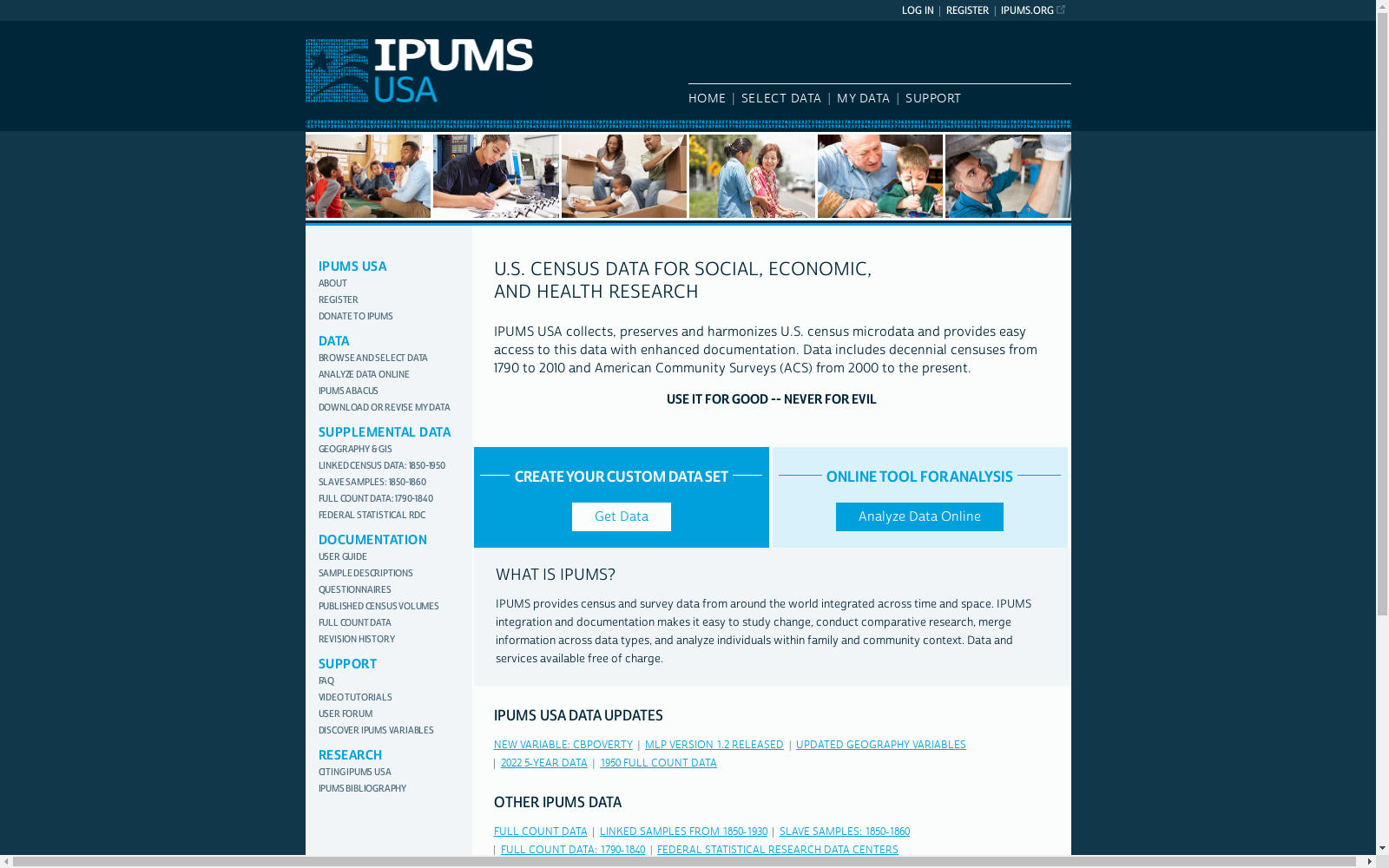IPUMS USA|人口普查数据集|社会经济分析数据集
收藏
- IPUMS USA首次发布,由明尼苏达大学人口中心创建,旨在整合和标准化美国人口普查数据。
- IPUMS USA增加了1990年美国人口普查的数据,进一步丰富了数据集的内容。
- 数据集扩展至包括2000年美国人口普查的数据,提升了其在社会科学研究中的应用价值。
- IPUMS USA引入了2010年美国人口普查的数据,继续保持其作为重要社会经济研究工具的地位。
- 数据集更新至包括2017年美国社区调查的数据,增强了其在微观数据分析中的实用性。
- 1IPUMS USA: Version 10.0 [dataset]University of Minnesota · 2020年
- 2The Integration of IPUMS USA Data into Social Science Research: A Review and Future DirectionsUniversity of California, Berkeley · 2021年
- 3Using IPUMS USA Data to Study Income Inequality in the United StatesStanford University · 2022年
- 4IPUMS USA Data and Its Application in Demographic AnalysisUniversity of Michigan · 2021年
- 5The Impact of IPUMS USA Data on Educational Research: A Case StudyHarvard University · 2022年
China Health and Nutrition Survey (CHNS)
China Health and Nutrition Survey(CHNS)是一项由美国北卡罗来纳大学人口中心与中国疾病预防控制中心营养与健康所合作开展的长期开放性队列研究项目,旨在评估国家和地方政府的健康、营养与家庭计划政策对人群健康和营养状况的影响,以及社会经济转型对居民健康行为和健康结果的作用。该调查覆盖中国15个省份和直辖市的约7200户家庭、超过30000名个体,采用多阶段随机抽样方法,收集了家庭、个体以及社区层面的详细数据,包括饮食、健康、经济和社会因素等信息。自2011年起,CHNS不断扩展,新增多个城市和省份,并持续完善纵向数据链接,为研究中国社会经济变化与健康营养的动态关系提供了重要的数据支持。
www.cpc.unc.edu 收录
中国区域地面气象要素驱动数据集 v2.0(1951-2020)
中国区域地面气象要素驱动数据集(China Meteorological Forcing Data,以下简称 CMFD)是为支撑中国区域陆面、水文、生态等领域研究而研发的一套高精度、高分辨率、长时间序列数据产品。本页面发布的 CMFD 2.0 包含了近地面气温、气压、比湿、全风速、向下短波辐射通量、向下长波辐射通量、降水率等气象要素,时间分辨率为 3 小时,水平空间分辨率为 0.1°,时间长度为 70 年(1951~2020 年),覆盖了 70°E~140°E,15°N~55°N 空间范围内的陆地区域。CMFD 2.0 融合了欧洲中期天气预报中心 ERA5 再分析数据与气象台站观测数据,并在辐射、降水数据产品中集成了采用人工智能技术制作的 ISCCP-ITP-CNN 和 TPHiPr 数据产品,其数据精度较 CMFD 的上一代产品有显著提升。 CMFD 历经十余年的发展,其间发布了多个重要版本。2019 年发布的 CMFD 1.6 是完全采用传统数据融合技术制作的最后一个 CMFD 版本,而本次发布的 CMFD 2.0 则是 CMFD 转向人工智能技术制作的首个版本。此版本与 1.6 版具有相同的时空分辨率和基础变量集,但在其它诸多方面存在大幅改进。除集成了采用人工智能技术制作的辐射和降水数据外,在制作 CMFD 2.0 的过程中,研发团队尽可能采用单一来源的再分析数据作为输入并引入气象台站迁址信息,显著缓解了 CMFD 1.6 中因多源数据拼接和气象台站迁址而产生的虚假气候突变。同时,CMFD 2.0 数据的时间长度从 CMFD 1.6 的 40 年大幅扩展到了 70 年,并将继续向后延伸。CMFD 2.0 的网格空间范围虽然与 CMFD 1.6 相同,但其有效数据扩展到了中国之外,能够更好地支持跨境区域研究。为方便用户使用,CMFD 2.0 还在基础变量集之外提供了若干衍生变量,包括近地面相对湿度、雨雪分离降水产品等。此外,CMFD 2.0 摒弃了 CMFD 1.6 中通过 scale_factor 和 add_offset 参数将实型数据化为整型数据的压缩技术,转而直接将实型数据压缩存储于 NetCDF4 格式文件中,从而消除了用户使用数据时进行解压换算的困扰。 本数据集原定版本号为 1.7,但鉴于本数据集从输入数据到研制技术都较上一代数据产品有了大幅的改变,故将其版本号重新定义为 2.0。CMFD 2.0 的数据内容与此前宣传的 CMFD 1.7 基本一致,仅对 1983 年 7 月以后的向下短/长波辐射通量数据进行了更新,以修正其长期趋势存在的问题。2021 年至 2024 年的 CMFD 数据正在制作中,计划于 2025 年上半年发布,从而使 CMFD 2.0 延伸至 2024 年底。
国家青藏高原科学数据中心 收录
FAOSTAT Agricultural Data
FAOSTAT Agricultural Data 是由联合国粮食及农业组织(FAO)提供的全球农业数据集。该数据集涵盖了农业生产、贸易、价格、土地利用、水资源、气候变化、人口统计等多个方面的详细信息。数据包括了全球各个国家和地区的农业统计数据,旨在为政策制定者、研究人员和公众提供全面的农业信息。
www.fao.org 收录
LFW
人脸数据集;LFW数据集共有13233张人脸图像,每张图像均给出对应的人名,共有5749人,且绝大部分人仅有一张图片。每张图片的尺寸为250X250,绝大部分为彩色图像,但也存在少许黑白人脸图片。 URL: http://vis-www.cs.umass.edu/lfw/index.html#download
AI_Studio 收录
CatMeows
该数据集包含440个声音样本,由21只属于两个品种(缅因州库恩猫和欧洲短毛猫)的猫在三种不同情境下发出的喵声组成。这些情境包括刷毛、在陌生环境中隔离和等待食物。每个声音文件都遵循特定的命名约定,包含猫的唯一ID、品种、性别、猫主人的唯一ID、录音场次和发声计数。此外,还有一个额外的zip文件,包含被排除的录音(非喵声)和未剪辑的连续发声序列。
huggingface 收录
